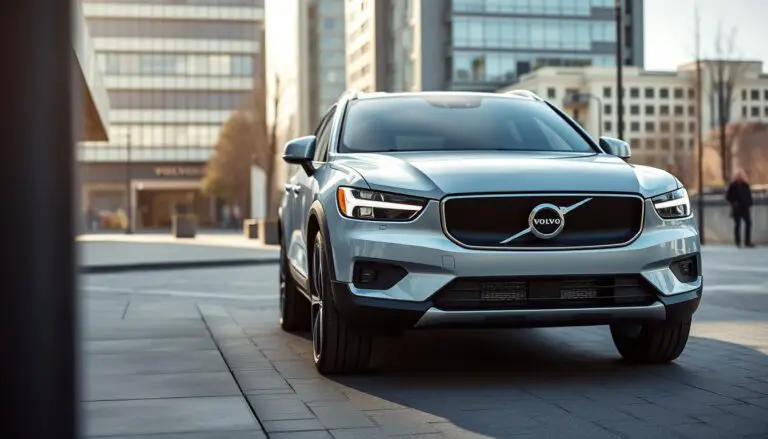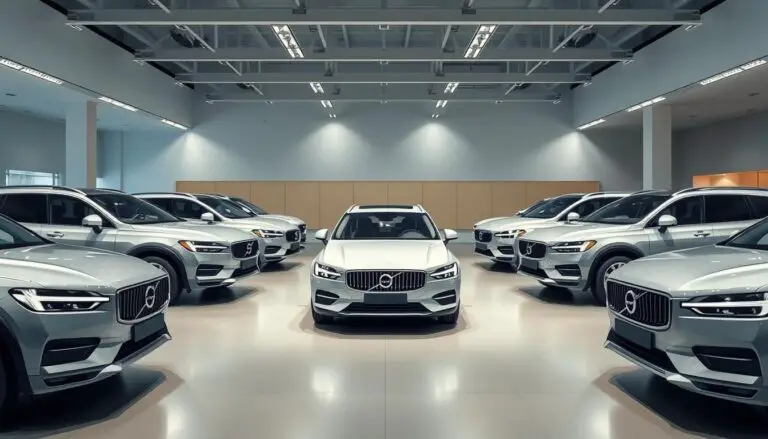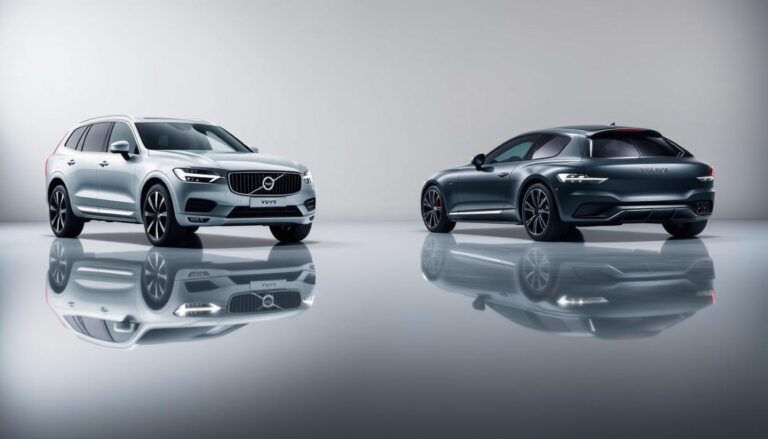The luxury wagon market is filled with impressive models, but two stand out among the rest: the Volvo V60 and the Volvo V90. Both vehicles embody the perfect blend of style, comfort, and performance, making them top contenders for those seeking a premium driving experience.
When it comes to choosing between these two luxury wagons, potential buyers often find themselves torn. The Volvo V60 is known for its agility and compact luxury, while the Volvo V90 offers more space and a refined driving experience. This article aims to provide a comprehensive comparison, helping you decide which model best suits your needs.
Key Takeaways
- Comparison of key features between Volvo V60 and Volvo V90
- Analysis of performance and comfort in both models
- Insights into which luxury wagon is best for different needs
- Examination of design and technology features
- Guidance on making an informed purchase decision
The Evolution of Volvo’s Luxury Wagons
As a stalwart in the automotive industry, Volvo has a rich history of producing luxury wagons that blend style, comfort, and performance. This heritage is evident in their current lineup, particularly in the V60 and V90 models.
Volvo’s Wagon Heritage and Design Philosophy
Volvo’s journey in wagon production dates back several decades, with a focus on practicality, safety, and Scandinavian design principles. Their wagons have always been designed to provide ample space, comfort, and a sense of luxury. The brand’s design philosophy emphasizes clean lines, minimalism, and functionality, making their wagons stand out in the luxury segment.
The Market Position of V60 and V90
The V60 and V90 are positioned differently in the market, catering to various customer needs. The V60 is seen as a more compact, agile option, ideal for those who prioritize handling and fuel efficiency. In contrast, the V90 is larger, offering more interior space and luxury features, appealing to those who value comfort and prestige.
Target Demographics for Each Model
The target demographics for the V60 and V90 differ based on their design, features, and overall appeal. The V60 tends to attract a younger demographic who value style, performance, and practicality. On the other hand, the V90 appeals to an older, more affluent audience who prioritize luxury, comfort, and advanced technology features.
| Model | Target Age Group | Income Level | Priorities |
|---|---|---|---|
| V60 | 25-45 | $75,000-$150,000 | Style, Performance, Practicality |
| V90 | 40-65 | $100,000-$250,000 | Luxury, Comfort, Technology |
In conclusion, Volvo’s luxury wagons, particularly the V60 and V90, embody the brand’s heritage and design philosophy while catering to different market segments and demographics.
Design and Exterior Comparison
A closer look at the Volvo V60 and V90 reveals distinct design languages that set them apart in the luxury wagon market. Both models embody Volvo’s design philosophy, emphasizing clean lines, functionality, and Scandinavian luxury.
Volvo V60 Exterior Styling and Design Language
The Volvo V60 boasts a sleek and modern exterior, characterized by its sloping roofline and muscular stance. Its design is both athletic and elegant, appealing to those who value both style and functionality.
Dimensions and Proportions
The V60’s dimensions are optimized for agility and maneuverability, making it ideal for urban environments. It has a length of approximately 476 cm, a width of 185 cm, and a height of 154 cm.
Volvo V90 Exterior Styling and Design Language
The Volvo V90 exudes a more premium and expansive presence, thanks to its longer wheelbase and more pronounced design elements. It is designed to offer a luxurious driving experience, both in terms of aesthetics and comfort.
Dimensions and Proportions
With a length of around 494 cm, a width of 186 cm, and a height of 147 cm, the V90 is larger than the V60, providing more interior space and a commanding road presence.
Design Differences and Similarities
While both models share Volvo’s signature design cues, such as the Thor’s hammer LED headlights, they differ in proportions and certain design elements. The V90 has a more elongated profile, contributing to its luxurious feel, whereas the V60 is more compact and agile.
Interior Quality and Comfort
When it comes to luxury wagons, the interior quality and comfort are just as important as exterior design and performance. Both the Volvo V60 and V90 are designed to provide a premium driving experience, with attention to detail in their interiors.
V60 Interior Design and Materials
The Volvo V60’s interior is characterized by its Scandinavian design philosophy, emphasizing simplicity, functionality, and premium materials. The cabin is adorned with high-quality materials, including leather upholstery, aluminum trim, and real wood accents.
Front and Rear Seat Comfort
The V60 offers comfortable seating for passengers, with supportive front seats featuring multiple adjustments and ample legroom. The rear seats are also spacious, providing adequate legroom and headroom for adult passengers.
V90 Interior Design and Materials
The Volvo V90 takes the interior design and materials to the next level, offering an even more luxurious experience. The interior features premium materials, including luxurious leather and genuine wood trim, creating a sophisticated ambiance.
Front and Rear Seat Comfort
The V90’s front seats are designed for long-distance comfort, with features like massage functions and ventilated seats available on higher trims. The rear seats are equally impressive, offering generous legroom and comfort for passengers.
Interior Space Comparison
When comparing the interior space of the V60 and V90, there are notable differences. The V90, being the larger vehicle, offers more interior space, particularly in the rear.
Headroom, Legroom, and Overall Spaciousness
| Model | Front Legroom | Rear Legroom | Front Headroom | Rear Headroom |
|---|---|---|---|---|
| Volvo V60 | 41.4 inches | 36.8 inches | 38.4 inches | 37.4 inches |
| Volvo V90 | 41.7 inches | 38.2 inches | 39.1 inches | 38.1 inches |
The table above illustrates the differences in interior space between the two models, highlighting the V90’s advantage in terms of legroom and headroom.
In conclusion, both the Volvo V60 and V90 offer luxurious interiors, but the V90 edges ahead in terms of overall spaciousness and premium feel.
Cargo Space and Practicality
When it comes to luxury wagons, cargo space and practicality are crucial factors to consider. Both the Volvo V60 and V90 are designed to offer ample cargo capacity, but there are differences that may sway your decision.
V60 Cargo Capacity Specifications
The Volvo V60 offers a generous cargo area, with a capacity of up to 23.2 cubic feet behind the rear seats. This expands to 50.3 cubic feet when the seats are folded, providing ample space for larger items.
Storage Solutions and Flexibility
The V60 also features clever storage solutions, including a spacious cargo area with tie-downs and a versatile seating arrangement that allows for easy configuration to suit different needs.
V90 Cargo Capacity Specifications
The Volvo V90, being the larger of the two, boasts an even more impressive cargo capacity, with up to 28.4 cubic feet available behind the rear seats. This expands to 59.7 cubic feet with the seats folded.
Storage Solutions and Flexibility
Like the V60, the V90 is equipped with thoughtful storage solutions, including a large cargo compartment with ample tie-down points and a flexible seating system.
Real-world Usability Assessment
In practical terms, both vehicles excel in daily usability, with easy-to-use cargo areas and comfortable driving dynamics. The V90’s larger size gives it an edge for long trips or when carrying large items, but the V60’s compactness makes it more agile in urban environments.
Performance and Powertrain Options
The performance and powertrain options in the Volvo V60 and V90 are designed to deliver a superior driving experience. Both models offer a range of engine options to cater to different driving preferences and needs.
V60 Engine Lineup and Performance Specs
The Volvo V60 is equipped with a variety of engines, including the T5, T6, and Recharge hybrid options. The T5 engine provides a balance between power and efficiency, while the T6 offers enhanced performance. The Recharge hybrid model combines the benefits of electric and gasoline power.
T5, T6, and Recharge Hybrid Options
The T5 engine in the V60 produces 250 horsepower, making it suitable for everyday driving. The T6 engine boosts this to 316 horsepower, offering a more dynamic driving experience. The Recharge hybrid model provides an impressive 400 horsepower and the added benefit of electric-only driving.
V90 Engine Lineup and Performance Specs
Similarly, the Volvo V90 offers the T5, T6, and Recharge hybrid engine options. These engines are designed to provide a blend of performance, efficiency, and environmental responsibility.
T5, T6, and Recharge Hybrid Options
The V90’s T5 engine delivers 250 horsepower, while the T6 engine produces 316 horsepower. The Recharge hybrid model offers 400 horsepower and advanced hybrid technology for improved fuel efficiency.
As Volvo’s official statement on performance highlights, “Our engines are designed to provide a perfect balance between power and efficiency, ensuring a driving experience that is both exhilarating and responsible.”
“The key to a great driving experience is not just about the power under the hood, but also about how the vehicle handles and responds to your input.”
Driving Dynamics and Handling Comparison
Both the V60 and V90 are designed to offer agile handling and responsive steering. The V60 is noted for its compact size, making it ideal for navigating tight city streets, while the V90 provides a more spacious and comfortable ride, suitable for long highway journeys.
Fuel Economy and Efficiency
When it comes to fuel economy, both models offer competitive figures, especially with the Recharge hybrid options. The V60 and V90 have similar fuel economy ratings, with the hybrid models offering the best efficiency.
| Model | Engine | Fuel Economy (mpg) |
|---|---|---|
| V60 | T5 | 24 |
| V60 | T6 | 22 |
| V60 | Recharge | 30 |
| V90 | T5 | 24 |
| V90 | T6 | 22 |
| V90 | Recharge | 30 |
In conclusion, both the Volvo V60 and V90 offer a range of performance and powertrain options to suit different driving needs. Their engine lineups, driving dynamics, and fuel economy figures make them competitive in the luxury wagon market.
Technology and Infotainment Features
In the realm of luxury wagons, the Volvo V60 and V90 stand out with their advanced technology and infotainment systems. Both models are designed to provide a seamless and connected driving experience, leveraging Volvo’s Sensus Connect system.
Sensus Connect System in V60 vs V90
The Sensus Connect system is a sophisticated infotainment platform that offers a range of features, including navigation, media playback, and smartphone integration. While both the V60 and V90 come equipped with Sensus Connect, there are some differences in how the system is implemented and the features available on each model.
The V90 offers a more comprehensive Sensus Connect experience, with additional features such as enhanced navigation and more extensive connectivity options.
Digital Displays and User Interface
Both models feature high-resolution digital displays that provide clear and intuitive access to various functions. The user interface is designed to be user-friendly, with a focus on simplicity and ease of use.
The V60’s 9-inch display is complemented by a more streamlined interface, making it easier to navigate through different menus and options.
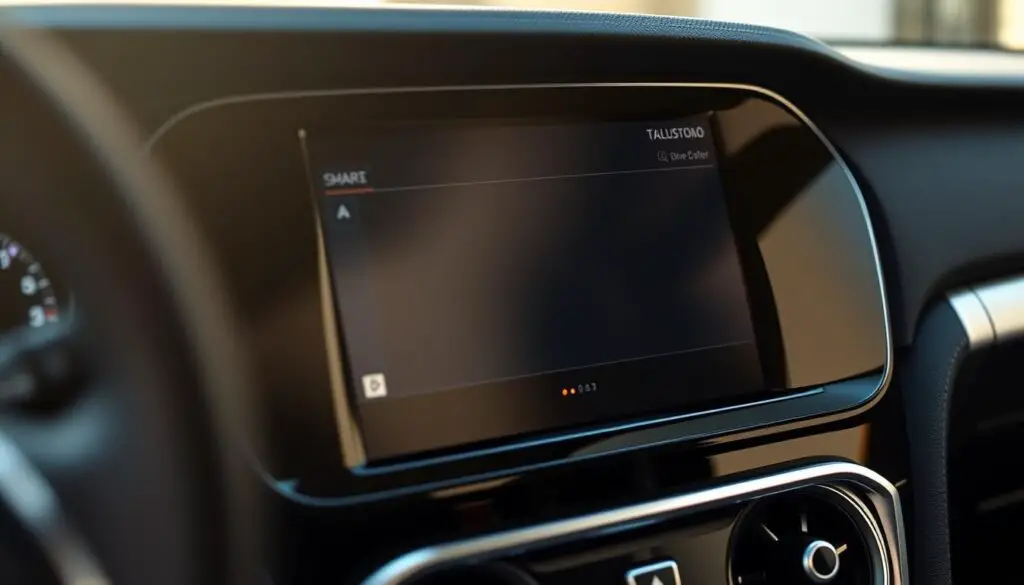
Connectivity and Smartphone Integration
Volvo’s Sensus Connect system supports seamless smartphone integration, allowing drivers to access their favorite apps and services on the go. Both models offer Apple CarPlay and Android Auto compatibility.
Premium Audio Options
For audiophiles, both the V60 and V90 offer premium audio systems designed to deliver exceptional sound quality. The Harman Kardon sound system available in the V90 is particularly noteworthy, offering a more immersive listening experience.
Safety Features and Innovations
Volvo’s commitment to safety is evident in the V60 and V90 models, which come equipped with a host of safety features and technologies. Both vehicles have been designed to provide a safe driving experience, incorporating numerous innovations to protect occupants and other road users.
Standard Safety Technologies in Both Models
Both the Volvo V60 and V90 come standard with a range of safety features, including City Safety, a collision avoidance system that can automatically apply the brakes in emergency situations. Additionally, they feature Run-Off Road Protection, which helps prevent accidents when the vehicle leaves the road.
Advanced Driver Assistance Systems
The V60 and V90 also offer advanced driver assistance systems, such as Adaptive Cruise Control and Pilot Assist, which enable semi-autonomous driving on certain roads. These systems enhance safety by reducing driver fatigue and improving reaction times.
Crash Test Ratings and Structural Safety
Both models have achieved excellent crash test ratings, thanks in part to their robust structural design and advanced safety features. The Volvo V60 and V90 have been designed to absorb and distribute the forces of an impact, protecting occupants and minimizing damage.
Model-Specific Safety Differences
While both models share many safety features, there are some differences in their safety profiles. For example, the V90 offers additional safety features as standard on certain trim levels, such as 360-degree camera views. A detailed comparison of the safety features of both models is provided in the table below.
| Safety Feature | Volvo V60 | Volvo V90 |
|---|---|---|
| City Safety | Standard | Standard |
| Adaptive Cruise Control | Optional | Standard on certain trims |
| 360-degree camera views | Optional | Standard on certain trims |
In conclusion, both the Volvo V60 and V90 offer exceptional safety features and innovations, making them among the safest vehicles on the road. The safety comparison between the two models highlights their shared commitment to protecting occupants and other road users.
Volvo V60 vs Volvo V90: Price and Value Analysis
Volvo’s luxury wagons, the V60 and V90, offer distinct value propositions that are reflected in their pricing. Understanding the nuances of their pricing and the value they offer is essential for making an informed decision.
Base MSRP and Trim Level Comparison
The base MSRP for the Volvo V60 starts at around $40,000, depending on the trim level and options chosen. In contrast, the Volvo V90 begins at a higher price point, typically around $50,000. The trim levels for both vehicles offer a range of choices, from the base model to the high-performance Polestar variants.
The V60 offers several trim options, including the Momentum, Inscription, and R-Design. Each trim level adds different features, such as upgraded interior materials and advanced safety features.
Standard Equipment Value Assessment
Both the V60 and V90 come with a comprehensive list of standard equipment. The V90, however, includes additional premium features as standard, such as a more advanced infotainment system and higher-quality interior materials.
“The Volvo V90 is equipped with a superior sound system and more advanced driver assistance technologies as standard.”
Optional Packages and Customization
Optional packages for both models allow for significant customization. The V60 and V90 offer various packages that can enhance performance, comfort, and technology.
Buyers can choose from a range of options, including the Convenience Package and the Luxury Package. These packages can significantly enhance the ownership experience.
Depreciation and Resale Value Projections
Depreciation and resale value are crucial factors in the overall cost of ownership. Historically, Volvo vehicles retain their value well.
The V90 tends to hold its value slightly better than the V60, according to industry projections. This is due in part to its larger size and more premium features.
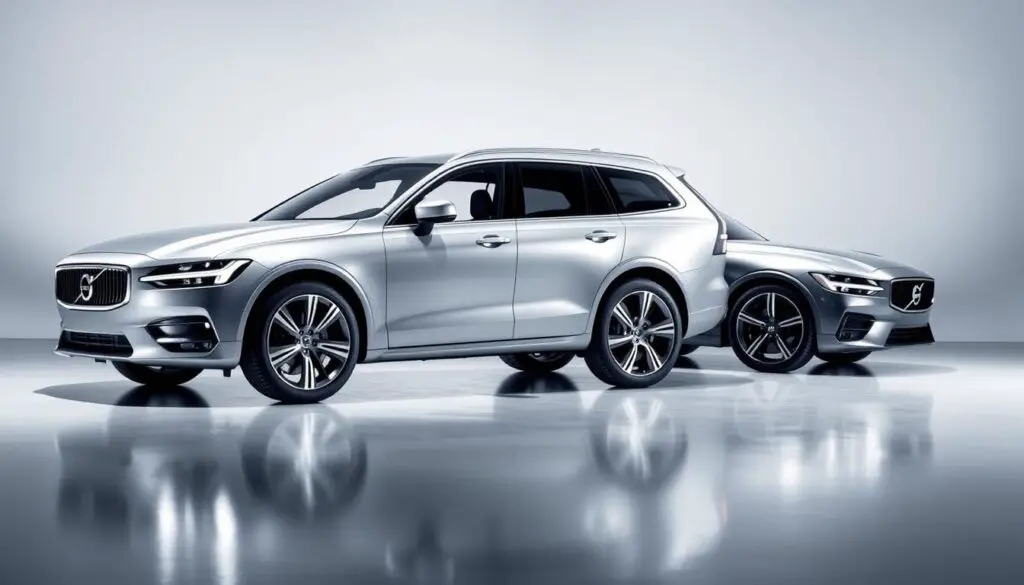
Ownership Experience and Long-term Costs
When considering the purchase of a luxury wagon like the Volvo V60 or V90, understanding the long-term ownership experience is crucial. This involves not just the initial purchase price, but also ongoing costs such as warranty coverage, maintenance requirements, and insurance expenses.
Warranty Coverage Details
Both the Volvo V60 and V90 come with a comprehensive warranty package. Volvo offers a new vehicle limited warranty that covers the vehicle for 4 years or 50,000 miles, whichever comes first. Additionally, there’s a 5-year/60,000-mile powertrain warranty. Understanding what’s covered under these warranties can help mitigate unexpected repair costs in the early years of ownership.
Maintenance Requirements and Costs
Regular maintenance is essential for the longevity of any vehicle. The V60 and V90 have similar maintenance schedules, with the first service typically due at 12,000 miles or 1 year. Volvo’s maintenance costs are generally in line with industry averages for luxury vehicles. However, the cost can vary based on the trim level and any custom options chosen.
Reliability Ratings and Common Issues
Volvo has made significant strides in reliability, with both the V60 and V90 scoring well in reliability surveys. However, as with any vehicle, there are potential issues to be aware of, such as problems with the infotainment system or occasional electrical glitches.
Insurance Cost Differences
Insurance costs can vary between the V60 and V90, largely due to differences in vehicle value and safety features. The V90 may incur slightly higher insurance premiums.
To summarize, here are key points to consider for long-term ownership:
- Comprehensive warranty coverage for peace of mind
- Regular maintenance is crucial for longevity
- Reliability has improved, but be aware of potential issues
- Insurance costs may vary between models
Conclusion: Which Volvo Wagon Is Right For You?
Choosing between the Volvo V60 and V90 ultimately depends on your specific needs and preferences. Both luxury wagons offer exceptional design, comfort, and performance. The Volvo V60 is ideal for those seeking a more compact, agile vehicle with a sporty edge, while the V90 is suited for buyers who prioritize interior space and luxury.
When considering the Volvo V60 vs V90 conclusion, it’s essential to weigh the importance of cargo space, driving dynamics, and premium features. The V90 offers more interior room and advanced features, making it a great choice for families or long-distance travelers. In contrast, the V60 provides a more responsive driving experience and is better suited for navigating tight city streets.
As a luxury wagon recommendation, both models excel in safety, technology, and overall driving experience. Your decision should be guided by your lifestyle and priorities. For a Volvo comparison summary, the V60 and V90 both embody the brand’s commitment to Scandinavian design and innovative engineering, ensuring a satisfying ownership experience regardless of your choice.
FAQ
What are the main differences between the Volvo V60 and Volvo V90?
The Volvo V60 and V90 differ in size, design, and features. The V90 is larger and offers more interior space, while the V60 is more compact and agile.
How do the engine options compare between the Volvo V60 and V90?
Both models offer similar engine lineups, including T5, T6, and Recharge Hybrid options. However, the V90 may have more powerful engine options available.
What are the cargo capacity specifications for the Volvo V60 and V90?
The Volvo V60 has a cargo capacity of up to 23.2 cubic feet, while the V90 offers up to 31.7 cubic feet of cargo space.
How do the Volvo V60 and V90 compare in terms of safety features?
Both models offer a range of standard safety features, including advanced driver assistance systems and crash test ratings. However, the V90 may have additional safety features available, such as a 360-degree camera system.
What is the price difference between the Volvo V60 and V90?
The Volvo V60 generally starts at a lower price point than the V90, with a base MSRP around ,000 compared to the V90’s starting price around ,000.
How do the Volvo V60 and V90 compare in terms of fuel economy?
The fuel economy of the Volvo V60 and V90 varies depending on the engine and trim level. However, the V60 generally has slightly better fuel economy ratings, with an estimated EPA rating of up to 27 mpg combined.
What are the key differences in interior design and features between the Volvo V60 and V90?
The Volvo V90 offers more premium interior materials and features, such as heated and ventilated seats, while the V60 has a more compact and sporty interior design.
How do the infotainment systems compare between the Volvo V60 and V90?
Both models feature the Sensus Connect infotainment system, with a similar user interface and features such as Apple CarPlay and Android Auto. However, the V90 may have additional features available, such as a larger touchscreen display.
What are the warranty and maintenance requirements for the Volvo V60 and V90?
Both models come with a similar warranty package, including a 4-year/50,000-mile new vehicle warranty and a 6-year/70,000-mile maintenance plan.
How do the Volvo V60 and V90 compare in terms of reliability and common issues?
Both models have a reputation for being reliable, with few common issues reported. However, the V90 may have slightly higher reliability ratings due to its more robust design and features.

